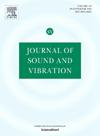Self-similar eigenvalue distribution of a binary tree-structured mass–spring–damper system
IF 4.3
2区 工程技术
Q1 ACOUSTICS
引用次数: 0
Abstract
The eigenvalue distribution of a binary tree-structured multi-degree-of-freedom linear oscillator is examined. The block masses and spring stiffnesses in the model are a power-law function of the tree level. A recursive formula is proven for the characteristic polynomial of the undamped system. For the power-law quotient the resulting characteristic equation is solved analytically and the eigenvalue distribution is derived as the function of the tree level up to the limit of the infinite tree. The importance of the eigenvalue distribution is demonstrated with examples of the dynamical behavior, when the system is subjected to small mistuning of its block masses. The mistuning perturbs the block masses by drawing a random value from a uniform distribution centered around the base value of each block mass. The width of the uniform distribution for each block mass is given by the product of the base value of the mass and the mistuning parameter . The displacement solutions of the governing differential equation with two sets of initial conditions are compared for different values of the mistuning parameter . Even though the mistuning has only a small effect on the eigenfrequencies of the system, it is concluded that the small perturbation of the block masses can cause a significant shift in the apparent frequency of the vibration.
二叉树结构质量-弹簧-阻尼系统的自相似特征值分布
研究了二叉树结构多自由度线性振荡器的特征值分布。模型中的块体质量和弹簧刚度是树级的幂律函数。证明了无阻尼系统特征多项式的递推公式。对幂律商σ=1/2的特征方程进行了解析求解,并导出了特征值分布作为树级的函数,直到无限树的极限。通过系统块体质量发生小误差时的动力学行为实例,说明了特征值分布的重要性。失谐通过从以每个块质量的基本值为中心的均匀分布中绘制随机值来扰乱块质量。每个块体质量均匀分布的宽度由质量基值与失谐参数r的乘积给出。对于不同的失谐参数r值,比较了具有两组初始条件的控制微分方程的位移解。结果表明,块体质量的微小扰动会引起振动表观频率的显著变化。
本文章由计算机程序翻译,如有差异,请以英文原文为准。
求助全文
约1分钟内获得全文
求助全文
来源期刊

Journal of Sound and Vibration
工程技术-工程:机械
CiteScore
9.10
自引率
10.60%
发文量
551
审稿时长
69 days
期刊介绍:
The Journal of Sound and Vibration (JSV) is an independent journal devoted to the prompt publication of original papers, both theoretical and experimental, that provide new information on any aspect of sound or vibration. There is an emphasis on fundamental work that has potential for practical application.
JSV was founded and operates on the premise that the subject of sound and vibration requires a journal that publishes papers of a high technical standard across the various subdisciplines, thus facilitating awareness of techniques and discoveries in one area that may be applicable in others.
 求助内容:
求助内容: 应助结果提醒方式:
应助结果提醒方式:


